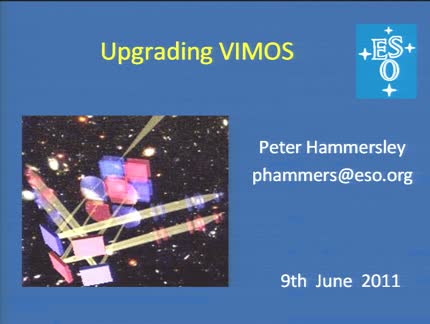Found 4 talks width keyword multi-object spectrograph

Abstract
The field of Galactic archaeology has been very active in recent years, with a major influx of data from the Gaia satellite and large spectroscopic surveys. The major science questions in the field include Galactic structure and dynamics, the accretion history of the Milky Way, chemical tagging, and age-abundance relations. I will give an overview of GALAH as a large spectroscopic survey, and describe how it is complementary to other ongoing and future survey projects. I will also discuss recent science highlights from the GALAH team and compelling questions for future work.

Abstract
MUSE (Multi Unit Spectroscopic Explorer) is a 2nd generation Integral Field facility for the VLT. With a field of view of 1x1 arcmin, fine sampling, intermediate spectral resolution and large spectral coverage in the visible, it uses a complex image slicer, twenty-four parallel spectrographs and a large detector area. In addition, MUSE is conceived to work assisted by the Adaptive Optics Facility (AOF), which will enhance notably its performance. MUSE is the result of ten years of design and development by the MUSE consortium — headed by the Centre de Recherche Astrophysique de Lyon, France and the partner institutes Leibniz-Institut für Astrophysik Potsdam (AIP, Germany), Institut für Astrophysik Göttingen (IAG, Germany), Institute for Astronomy ETH Zurich (Switzerland), L'Institut de Recherche en Astrophysique et Planétologie (IRAP, France), Nederlandse Onderzoekschool voor de Astronomie (NOVA, the Netherlands) and ESO.
MUSE has been successfully installed on ESO’s Very Large Telescope (VLT). In this talk it will be presented the instrument, its design and challenges, the integration (both in Europe and Paranal), the first light and first commissioning results.

Abstract
The 2nd generation VLT instrument Multi Unit Spectroscopic Explorer(MUSE) is going to be an integral field spectrograph with wide field of view and high spatial sampling. It is currently being built by a European consortium to see first light end of 2012. I will describe instrumental properties, show some details of the optomechanical design, present the data processing, and give some examples for possible scientific use.

Abstract
VIMOS is visible multi-object spectrometer operating on the VLT. The high multiplex of the VLT visible imager and multi object/integral-field spectrometer, VIMOS, makes it a powerful instrument for large-scale spectroscopic surveys of faint sources. Following community input and recommendations by ESO's Science and Technology Committee, it was decided to upgrade the instrument in phases. The first phase of the upgrade is described and included changing the shutters, installing an active flexure compensation system, replacing the detectors with CCDs with a far better red sensitivity and less fringing, and improving the data reduction pipeline.
« Newer Older »
Próximas charlas
- Classical Be stars - Constraining binary interaction physics in massive starsDr. Julia BodensteinerThursday April 25, 2024 - 10:30 GMT+1 (Aula)
- Runaway O and Be stars found using Gaia DR3, new stellar bow shocks and search for binariesMar Carretero CastrilloTuesday April 30, 2024 - 12:30 GMT+1 (Aula)









